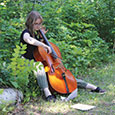Renee Shane-Boyd has been director of bands at Catalina Foothills High School in Tucson, Arizona since it opened in 1992, although she has been a teacher in the Catalina Hills District for a decade longer. “Catalina Foothills High School was a brand new high school in 1992 and the first high school in our district, which had previously been K-8. When I started, I taught at a middle school and two elementaries. Then we added an elementary in the district, and another middle school a year before the high school opened. The growth of the district meant that there have always been new opportunities here, and I have stayed for my entire career, which is now in its 31st year overall and 21st at the high school.
“Although I wanted to be a high school director in college, starting in elementary and middle schools was a good thing because it taught me about teaching and working with children. I learned quickly that you needed to enjoy that you were working with children, not just that you were teaching music. The program will not fade away the next day if a beginning clarinetist is momentarily unable to cross the break. Once I was able to relax and learn that, it gave me a whole new perspective on what I was doing.”
Shane-Boyd is also the president of the Arizona Music Educators Association this year, which marks the organization’s 75th anniversary. In addition to planning the state music conference and celebration, she is working on ways to help young teachers in the state. “A recently retired teacher is going to start a state-wide mentorship network to work with new teachers. We are also trying to work on communication with young population of teachers. We recently changed our newsletter to an online version and are also going to develop a blog site linked to the news letter and the AMEA web site. Ultimately, the best way for a new teacher to benefit from a state organization is to attend these conference festivals, meet people, and learn from experienced teachers.”
Shane-Boyd is also the president of the Arizona Music Educators Association this year, which marks the organization’s 75th anniversary. In addition to planning the state music conference and celebration, she is working on ways to help young teachers in the state. “A recently retired teacher is going to start a state-wide mentorship network to work with new teachers. We are also trying to work on communication with young population of teachers. We recently changed our newsletter to an online version and are also going to develop a blog site linked to the news letter and the AMEA web site. Ultimately, the best way for a new teacher to benefit from a state organization is to attend these conference festivals, meet people, and learn from experienced teachers.”

How do you use technology in your classes?
Technology has changed the way I teach, and it was exciting to cross the cusp from where we used very little technology to what we do now. It can reach students in a different way than teachers can, and we have seen better retention of both visual and musical concepts, especially with younger students.
We do quite a bit of video and audio recording. Four years ago I bought a digital recorder for $400 and I use it frequently. We also use cell phones and tablets to make videos on the spot. Our district just instituted a bring-your-own-device policy, and under certain guidelines, students can use their devices in the classroom to assist in instruction. We will sometimes record video of students from the symphonic band demonstrating marching techniques and put it on YouTube for me to show to the concert band in the next class period.
We use drill-writing software with an interactive feature that allows students go online and watch their dot in the drill. I can play it back for them in class and isolate it by moves. I will have students count through and play with it. Visual learners are especially able to get a much better understanding of what we are asking them to do on the field through watching this.
A band parent with a high-quality video camera records our performances at marching competitions, and over the weekend he will dub the judges’ comments over the film. We post this video on a private YouTube link so students and parents can watch the comments that same weekend. It opened the eyes of a lot of parents about marching competitions and the feedback we receive.
The other thing I like technology for is communication. I never friend students on Facebook, but we have a private Facebook group we use for communication. Students have to sign a form before they are allowed to join. I also have a Twitter account for similar purposes; students can follow me on Twitter, but there is rarely any interaction there.
YouTube has changed my life in terms of how I teach, especially jazz combos; we use it frequently in jazz classes. When I only taught concert band, I never felt I should play the music for students because I did not want them to learn it by rote. I have students in all ensembles listen to and evaluate their playing when we record it and will also have them compare it to professional-level players. I especially do that with jazz. In fact, teaching jazz taught me that students have to listen, and that is why I transitioned to using it in non-jazz classes so much. I saw Willie Hill give a workshop on jazz articulation at one of our conferences. He espoused using recordings so students could really hear the articulation before they tried to make any sense of playing a tune. I still never teach by rote, but now I better understand the value of learning styles through listening, and in the combo class, we never learn a tune without listening to it first.
Finding jazz recordings was difficult before online video; to let students see who Count Basie was and watch him play, you had to order the VHS tape and wait for it to be delivered. Now if we are working on a piece and I decide students just aren’t getting it, we can find it on YouTube, often with video of the performance. Sometimes we just listen without too much guidance from me, especially with advanced combos, where we just listen so students can learn about the solo style or what kind of licks they play, but with less experienced combos I offer much more guidance. I have the drummer listen to what the drummer is doing and have the bassist listen to what type of time is kept and the pianist listen for how much comping is happening so they don’t feel like they have to have a wall of sound going all the time.
What is the key to building a strong instrumental music program?
Avoid getting so wrapped up in what festival you want to attend or what music you want students to play that you forget the real goal ought to be making students into independent musicians who will choose to continue playing music the rest of their lives. The auxiliary things, such as travel, will come if students get an experience that means something to them and get to the point where they can play at a level where they can really enjoy it.
Part of getting students to a high level is asking them questions rather than just giving them the information back after they play. Since moving to high school, the most important thing I have learned is the importance of teaching students to listen. I was a good direct teacher. I could hear a band, give them information, and move quickly through a rehearsal, but what I have learned through watching other directors is that if students are forced to listen, give good feedback, and make decisions about what they are doing, they pick up things much quicker, retain the information, and are able to transfer it to other areas.
There is much talk about critical thinking in schools these days, but few people realize how much critical thinking musicians have to do when playing in a high-level ensemble. Besides the theory and the skills needed to produce a correct tone and understand music reading, students have to learn to listen, make good decisions, and ask themselves the right questions as they are playing.
What is the best way to get and keep the largest number of students in instrumental music?
It is important to offer a music program where students feel comfortable. It took me a few years to learn that it was probably unwise to force a diehard jazz musician to be in the marching band. Offer a broad range of programs so the most possible students will be involved and find a place they can be comfortable.
We have three concert bands, and placement in each is mostly based on ability. The wind ensemble consists of the most advanced musicians. The symphonic band is the second group; students can automatically move into this group when they become juniors. The concert band is primarily freshmen and sophomores. Auditions usually consist one of the Arizona All-State etudes, scales, and sightreading. The three concert bands combine with a drumline, color guard, and pom line to form the largest marching band in the state. After graduating 82 seniors last year we are marching 232, although we average around 250. Participation in marching band is required for everybody enrolled in one of the concert bands, but students can enroll in other ensembles without being in concert and marching band.
We have both jazz band and jazz combo classes. The jazz combo class developed because there were usually too many saxophone players for one jazz band and rarely enough trombonists for a second one. Our jazz band is requires an audition, and we try to keep standard instrumentation so students can have a good jazz experience. We have more students interested in jazz than spots in the band, so we also have a combo class. This year we have four combos in one class and a fifth combo that meets during the small ensemble period. The combo class works as a good feeder for the jazz band, although there are some students who prefer it and do not go on to jazz band. It also provides a way to involve additional bass players, guitarists, pianists, and drummers in the program. When we go to festivals, the clinicians are always excited to see the combos because that is the way much of the jazz music is made in the adult world, and they are glad students have that opportunity.
Our small ensemble class was initially student generated; the first group we had was a woodwind quintet. When the full-time ensembles first started, they were registered in one of the band classes but would meet separately in a practice room while we rotated in coaching them. As the program grew, we were able to justify having it as a separate class, and we have always had at least a couple ensembles in that class. This year, in addition to the one jazz combo, the small ensemble class has a flute choir and clarinet choir. There is also a saxophone quartet that works on its own; students are not enrolled in the class. The chamber groups in the small ensemble class change from year to year depending on student interest.
The small ensemble class has also become home to several students who wanted to continue on their instruments but were involved in athletics and could not meet the time commitments necessary for one of the concert bands. We wanted to always have an option for them to continue playing. Our high school has always had more than a standard six-period day. It is usually seven, but some years it has been eight periods; this is helpful to all elective programs. Because we have more time in the day and more classes to fill, it made sense to add a specialized class like this one.
Why did you start a steel band program?
We started a steel band a couple years after opening the high school. I began the program to broaden the musical offerings so we had more students in the school involved in instrumental music. Another high school in town, Tucson High School, had a successful steel band program, and the University of Arizona had a strong steel program as well, so I talked with both those directors about their programs and the logistics of starting one. Getting the instruments tuned is difficult, so we went with the same pan maker that the University of Arizona used, Cliff Alexis at Northern Illinois University.
I led the group for four or five years, but our program could not grow because there was only room for a couple of classes during the day. We hired an assistant who was a percussionist, and she has expanded the program to include beginning, intermediate, and advanced steel bands.
The steel band is open to anyone. Many of the students in the intermediate and advanced groups are in another musical ensemble as well, and having students with those skills allows us to have intermediate and advanced steel bands. Some of the students in the beginning band have never played an instrument before and do not even read music before joining the class. Tina Walton, our percussion teacher, does a lot of work with basic note-reading skills with the beginning steel band.
Do not be afraid to try new things to get students involved. I love teaching concert band, but offering other opportunities for students, whether it is guitar or steel band, is not going to make your program weaker. I think people are afraid of that. Many guitarists come in to the combo class just reading tabs. The biggest part of the audition process for them to get into that class is indicating whether there is a willingness to learn how to read music or an understanding of what the chord symbols mean. One student came in as a freshman and wanted to play guitar but couldn’t read music. I gave him a method book and said, “Go.” By his senior year he was the bass player in the all-state jazz band. It is great to have a place for students like that to fit in. If you plan effectively, it will only make your program stronger, so look for ways to involve as many students as possible.
What are the best ways to build student enthusiasm in the program?
Students can be given responsibilities and even do some of the teaching. One of the things that I enjoy, especially at the high school level, is working with student leaders and talking with them about group dynamics. Often there are a wide variety of motivations within a group, and students learn how exciting it is to motivate a large group of people to work toward a common goal. The students in the program really look forward to becoming leaders so they have the opportunity to teach.
Student leaders receive training in spring and summer, and then they teach all of the basic marching skills at band camp. We tell student leaders that the most important thing we want from them on the field is to be good role models of the behavior we want from everyone, but they also have time during marching practice to make corrections and help other students. The most difficult thing about teaching marching band is always getting new students up to speed. With a large group it is difficult to give individual attention so this is a good opportunity to use peers to teach.





